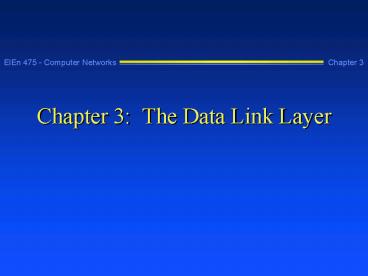Chapter 3: The Data Link Layer - PowerPoint PPT Presentation
1 / 24
Title:
Chapter 3: The Data Link Layer
Description:
... Link Control (SDLC) ... SDLC is capable of supporting both half-duplex and full-duplex ... Extended address: SDLC allows for an 8-bit address, whereas HDLC ... – PowerPoint PPT presentation
Number of Views:23
Avg rating:3.0/5.0
Title: Chapter 3: The Data Link Layer
1
Chapter 3 The Data Link Layer
2
Learning Objectives
- Frame
- Parity
- Arithmetic Checksum
- Error Correction
- Hamming Distance
- Hamming Code
continued
3
Learning Objectives
- Asynchronous Transmission
- Synchronous Transmission
- BISYNC Transmission
- Data Link Escape
- Byte Count Synchronous Transmission
- Synchronous Data Link Control
- High-level Data Link Control
continued
4
Introduction
- The second layer of the OSI model is the data
link layer and resides immediately above the
physical layer. - The responsibilities involve
- Transforming the physical layer into a
transmission line that appears free of
transmission errors.
5
Frame
- The data link layer creates a unit called a
frame. - A frame typically contains one or more fields
that are involved in transforming the physical
layer into an error-free transmission line. - The frame is passed to the senders physical
layer which then transmits the frame over a
medium to the physical layer of the receiver.
continued
6
Frame
- The frame is placed the information necessary to
- Perform error checking of the transmitted data.
- Control lost and duplicate frames.
- Provides the means to prevent a transmitter from
overrunning a receiver with data faster than the
receiver can process it.
continued
7
Error DetectionMurphys Law
- The transmission of data over an appropriate
medium is much likely Murphys Law if something
can go wrong, it will.
8
Error Detection Techniques
- Parity
- Arithmetic Checksum
- Cyclic Redundancy Checksum
- Simple parity is the easiest error detection
method to incorporate and comes in two basic
forms even parity and odd parity - Double parity tries to solve the problem of
detecting even numbers of errors by adding
additional parity check bits.
9
Error Detection
- A more advanced technique of error detection is
arithmetic checksum. While this technique does
not have widespread use, it is relatively simple
to program and reasonably effective. - The checksum value is created by adding together
the ordinal values of each character in a
transmitted packet. This checksum is then
appended to the packet of transmitted data in the
form of one or two characters.
10
Error Detection
- The cyclic redundancy checksum (CRC) is one of
the few cases in computer science where you get
more than you paid for. The CRC methods usually
adds 16 or 32 check bits to potentially large
data packets while approaching near 100 percent
error detection.
11
Error Correction
- The concept of error correction is often
interpreted in two different ways - Error Correction
- Forward Error Correction
- In error correction the data is transmitted to a
receiver the receiver performs an error
detection procedure and discovers the data is
corrupted.
12
Error Correction
- The forward error correction requires the
transmitter to transmit a great deal of
additional information along with the original
data.
13
Hamming Distanceand Hamming Code
- Hamming distance is the smallest number of bits
by which character codes differ. - A Hamming code is a data code that includes the
redundant bits necessary to perform forward error
correction.
14
Asynchronous Transmission Synchronous
Transmission
- Asynchronous transmission is one of the simplest
examples of data link protocol and is found
primarily on point-to-point connections. - Synchronous transmission is markedly different
from the asynchronous transmission in that the
unit of transmission is not a single character
but a sequence of characters.
15
BISNYC Transmission
- BISYNC protocol was designed to provide a
general-purpose data link protocol for
point-to-point and multipoint connection. - BISYNC (or BSC) is a half-duplex protocol in that
it allows data to be transmitted in both
directions, but not at the same moment.
16
Transparency
- Transparency is a system that allows the binary
equivalent of the ETX (End of TeXt) character to
occur in the text but not be recognized as the
control character ETX.
17
Synchronous Data Link Control (SDLC)
- SDLC (Synchronous Data Link Control) is a bit
synchronous protocol with it, the receiver
examines individual bits looking for control
information.
18
Comparison of SDLC and BISNYC
- SDLC is capable of supporting both half-duplex
and full-duplex connections where BISYNC is
essentially half-duplex, since the primary sends
a message, the secondary responds, the primary
sends another message, the secondary responds,
and so on.
19
Comparison of SDLC and BISNYC
- SDLC is a code independent whereas BISYNC is code
dependent. BISYNC requires a data code such as
ASCII or EBCDIC that includes control codes such
as SOH (Start Of Header), STX (Start of TeXt), or
ETX (End of TeXt) in the code set.SDLC does not
rely on character codes to control execution.
20
High-level Data Link ControlHDLC
- HDLC (High-level Data Link Control is the data
link standard created by ISO that closely
resembles SDLC.
21
Comparison of HDLC and SDLC
- Extended address SDLC allows for an 8-bit
address, whereas HDLC can be extended to have an
address size that is multiple of 8 bits. - Extended control field The control field in HDLC
may be 8 bits (as in SDLC) or 16 bits in length.
22
Comparison of HDLC and SDLC
- Extended checksum the cyclic checksum field may
be either 16 bits (as in SDLC) or an extended
32-bit checksum. - Selective reject Supervisory frames in SDLC can
be Receive Ready, Receive Not Ready, and Reject.
HDLC adds Selective Reject (SREJ), which tells the
23
Comparison of HDLC and SDLC
- sender that a message was in error and to go
back to than one message and retransmit it but
not all the messages that followed it.
24
(No Transcript)































